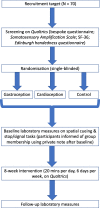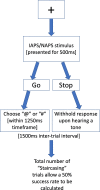Where is an emotion? Using targeted visceroception as a method of improving emotion regulation in healthy participants to inform suicide prevention initiatives: a randomised controlled trial
- PMID: 32664997
- PMCID: PMC7362633
- DOI: 10.1186/s13063-020-04479-9
Where is an emotion? Using targeted visceroception as a method of improving emotion regulation in healthy participants to inform suicide prevention initiatives: a randomised controlled trial
Abstract
Background: William James' 1884 paper "What is an emotion?" has generated much recent interest in affective science regarding somatic contributions to emotion. Studies of interoception ("sensing the physiological condition of the body") suggest that sensing specific parts of the body contributes to the production of emotion, namely when sensing the viscera (i.e. "visceroception" of the heart, gut or lungs). Improved visceroception has, for instance, been linked to increased emotional intensity, suggesting a role for interoception in emotion regulation that may pertain specifically to visceral bodily locations. Thus, in addition to asking James' question, "What is an emotion?", we ask, "Where is an emotion?". Further, there is an evidence base pointing to the connections between emotion regulation and suicide, and between interoception and suicide. This is a preliminary trial investigating whether targeted interoception/visceroception improves emotion regulation. Ultimately, the overall project aims to inform suicide prevention efforts.
Methods: The trial utilises a pre-test/post-test control group design, with two experimental groups undergoing visceroceptive interventions (focussing on areas pertaining to the gut or heart) and a control group. The interventions will run for 8 weeks. A spatial cueing task will measure reaction times to bodily changes relating to lower abdomen or chest focus. A stop/signal task will measure emotional inhibition, which is hypothesised to obscure awareness of active bodily locations. Visceroceptive ability will be tracked using a heartbeat estimation task, a water load test, and by self-report questionnaire. The sample will consist of healthcare professionals and healthcare students. Despite these being groups that represent a relatively high suicide risk among professional and student groups, all participants will be healthy, given the preliminary nature of this trial.
Discussion: To our knowledge, this will be the first project to address whether emotional feeling presents as a localised bodily phenomenon and whether trained awareness of emotional localisation can improve emotion regulation. It will also be the first to investigate relationships between interoception and emotional inhibition (i.e. whether a sustained interoceptive practice leads to the disinhibition of bodily emotional sensations, which can positively contribute to emotion regulation). These empirical findings on emotion regulation from a healthy sample will be used to inform a desk-based enquiry into the role of embodied emotion in suicide prevention, which may make a significant contribution to a growing evidence base on interoception and suicide.
Trial registration: ACTR N12619000324112 . Registered on 4 March 2019. Universal Trial Number (UTN): U1111-1221-0201.
Keywords: Emotion regulation; Interoception; Localisation; Suicide; Visceroception.
Conflict of interest statement
The authors declare that they have no competing interests.
Figures
Similar articles
-
Where is an emotion? Using an emotional spatial cueing task to test for emotional localization following targeted visceroception.Scand J Psychol. 2024 Feb;65(1):104-118. doi: 10.1111/sjop.12959. Epub 2023 Aug 24. Scand J Psychol. 2024. PMID: 37615307
-
Do interoceptive accuracy and interoceptive sensibility predict emotion regulation?Psychol Res. 2021 Jul;85(5):1894-1908. doi: 10.1007/s00426-020-01369-2. Epub 2020 Jun 16. Psychol Res. 2021. PMID: 32556535
-
Where is emotional feeling felt in the body? An integrative review.PLoS One. 2021 Dec 22;16(12):e0261685. doi: 10.1371/journal.pone.0261685. eCollection 2021. PLoS One. 2021. PMID: 34936672 Free PMC article. Review.
-
Multidimensional Assessment of Interoceptive Abilities, Emotion Processing and the Role of Early Life Stress in Inflammatory Bowel Diseases.Front Psychiatry. 2021 Jun 24;12:680878. doi: 10.3389/fpsyt.2021.680878. eCollection 2021. Front Psychiatry. 2021. PMID: 34248716 Free PMC article.
-
Facilitating Adaptive Emotion Processing and Somatic Reappraisal via Sustained Mindful Interoceptive Attention.Front Psychol. 2021 Sep 8;12:578827. doi: 10.3389/fpsyg.2021.578827. eCollection 2021. Front Psychol. 2021. PMID: 34566738 Free PMC article. Review.
Cited by
-
Is It a Gut Feeling? Bodily Sensations Associated With the Experience of Valence and Arousal in Patients With Inflammatory Bowel Disease.Front Psychiatry. 2022 Apr 22;13:833423. doi: 10.3389/fpsyt.2022.833423. eCollection 2022. Front Psychiatry. 2022. PMID: 35530019 Free PMC article.
References
-
- James W. What is an emotion? Mind. 1884;9:188–205.
-
- Damasio AR. Descartes’ error and the future of human life. Sci Am. 1994;271(4):144. - PubMed
-
- Craig AD. Interoception: the sense of the physiological condition of the body. Curr Opin Neurobiol. 2003;13(4):500–505. - PubMed
-
- Wiens S, Mezzacappa ES, Katkin ES. Heartbeat detection and the experience of emotions. Cognit Emot. 2000;14(3):417–427.
Publication types
MeSH terms
Grants and funding
LinkOut - more resources
Full Text Sources




